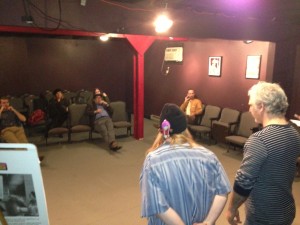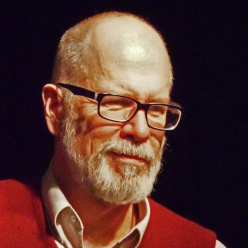Author: Michael
Coaching and improv: more musings.
I am offering free sample coaching conversations. If you’d like to explore coaching with me, drop me an email at michaelburns@mopco.org
Improv, Creativity, Coaching, and the "No Questions Rule"
The happiest, most fulfilled, most balanced people I know have one thing in common: they are creators. I’m not just talking about artists–I’ve worked with all kinds of people who are in no way artists, but they are people who habitually approach their lives and work in a creative way. They look at a challenge on the job, or in their personal relationships, or in their day to day living, and see the chance to make something new happen instead of an impassable roadblock. They perceive imbalance, and through creative inquiry, find a way to adjust and create balance. They hear dissonant noise, and through experiment, find the way to make a pleasing chord.
These folks tend to know a lot about themselves and about people in general. Paradoxically, this leads them to know that there is a huge amount that they don’t know, not by a long shot. They are comfortable being curious about themselves and others. They aren’t afraid to delve into their own minds and see what surprises are there. They ask questions of others all the time, because they genuinely want to know the answers. They never consider that not knowing makes them look stupid or less-than.
So: a key part of my coaching involves celebrating curiosity, mine and my clients’. We ask questions together, and in those questions and the thoughts they lead to we find the fuel for the engine of positive change.
This curiosity, this openness to discovery relates to an ongoing discussion I’ve had for years with improvisers and other improv trainers. There is a fairly widely accepted improv “rule” offered to beginning improvisers that states: “no questions.” Now, I don’t really believe in many of the commonly accepted hard and fast improv rules, because they are all too easily broken, often with excellent results. The “no questions” rule was developed as advice to new improvisers, in an attempt to avoid a certain type of anxiety-based question that tends to shut down a scene.
Its an oversimplification, but I talk to my students about “good cholesterol” and “bad cholesterol” questions. The “bad cholesterol” questions are caused by blockage. The “good cholesterol” questions are lubricants that facilitate creative action.
In a typical rookie improv scene, you might see the following:
Character One and Character Two are on stage, and they are scared. Painfully conscious of the audience, the lack of a script, and the driving need to be funny and clever, they have both shut down. In a panic, they have forgotten all training. Character One turns to Character Two and says “What should we do now?”
Character Two: “I don’t know!” Both stare helplessly at each other, unable to think of anything “funny” to say…and the scene dies a slow and painful death.
Now, the problem with the “no questions” rule is that it is an attempt to fix the symptom, instead of addressing the real issue, in the above scenario. Before the question is asked, the two improvisers are already outside of the creative space, and adding that negative rule just adds to the things they are doing wrong. The last thing they need is to be wrong. But as soon as the question is asked, Character One remembers the rule, and beats herself up for breaking it. Character Two remembers the rule, and resents her for asking. Both players are stuck in a negative wasteland, now even farther outside of the creative space.
I shudder to think how many times I’ve seen that scene, and I’ll admit it–played that scene, in life and on stage.
Consider, then:
Character One and Character Two are on stage, and they are scared. Painfully conscious of the audience, the lack of a script, and the driving need to be funny and clever despite the advice that they don’t need to be either, they are both on the verge of shutting down. But suddenly Character One, remembering something from her training, breathes, relaxes, and opens up to really seeing Character Two. Without stopping to think, she says:
“When are we supposed to be at the party? It is tonight, right? Did you print out the email?”
“Character Two frantically pats his pockets…”Here it is! Yes, it’s tonight. And we’re late! We’ve got to hurry!” Character Two, delighted at having something to do, has remembered to say yes, and…
Suddenly the scene has someplace to go. Character One has asked not one but three questions, questions that came from a genuine acknowledgement of the mutual fear that she and her partner feel, and perhaps from some unconscious connection with something she noticed about her scene partner–perhaps a patting of the pocket or a look around the stage. Their adrenaline now has an outlet–frantic preparation for the party, or a mad dash for the car, or perhaps, some more of their training returning to them because of the release of their panic, they do a time dash to the party itself…
As they progress, these improvisers discover that the fear that fed this first scene is not necessary, that they won’t, in fact, die up there on stage. They learn that the “good cholesterol” questions that spring to mind are greatly liberating. As they get more comfortable, their natural curiosity can serve as the launch pad for hundreds of successful scenes.
So, the “no questions ” rule, for me, is a blind alley– a way that we can heighten the anxiety, rather than feed the natural curiosity of ourselves. So, in true coaching fashion, I leave you with a few questions:
Where are the equivalents to the “no questions rule” in your mind? What symptoms do they address, and what state of discomfort is the actual root of those symptoms? When do you find yourself open and curious when you face a challenge?
I am offering free sample coaching conversations. If you’d like to explore coaching with me, drop me an email at michaelburns@mopco.org.
The Driver’s Dilemma
Recently at Mopco we’ve been rehearsing Spontaneous Broadway, a show that consists of improvised songs in the first act, and a long form musical built around a reprise of one of those songs in the second.
It’s a show that requires the impossible, which of course is why improvisers love it.Having little more than a handful of ragtag costumes and an agreed-upon title and opening location to go on, the cast must write, edit, direct and perform a musical play in real time, in front of the opening night audience.
It’s a form that brings out the driver in some of us. And the wimper, and the bridger.
If you don’t know what the heck I am talking about, apologies. Driving= moving the action forward by overwhelming the offers of your partners, and therefore blocking them. Wimping= not doing anything for fear of making a mistake. Bridging= putting off an inevitable outcome for fear of the unknown results—“I am going to shoot!….some day…..really! I mean it…..” If you are going to shoot, shoot. If you enter a scene, do something, simply and definitively. And if your partner makes an offer, don’t ignore it because you have a better one…the audience will sense that conflict/tension and become uncomfortable.
So, the other night in rehearsal we were discussing driving. Kat Koppett (Mopco co-director and creator of the form Spontaneous Broadway) had this to say about driving: “When you feel as if you know exactly what should happen, and feel compelled to make it happen—don’t. Chances are you are wrong, and someone else, who actually does know, will do the right thing if you let them.”
Zen and the art of improv, summed up by Kat Koppett.
Someone is thinking: but–if everyone followed that advice, we would never do anything, right? Nope. Kat went on to say (Kat, please forgive the paraphrase)”When you feel that way, it’s because you are writing instead of listening. We must listen to each other, and be scrupulous about yes-anding the offers that are out there—that way, the story goes forward organically, and the audience is amazed.”
So, the driver’s dilemma is: I know I know what should happen, but I know (because Kat told me) I am wrong. But…but…but…. Like a creaky overloaded computer tricked by Mr. Spock into meltdown, this improviser freezes, and essentially leaves the show. (Wimping/bridging and driving being, after all, two sides of the same coin.)
What’s the prescription? Same old thing. Listen. Relax. Breathe. Create no action; rather, allow yourself to be moved to action by the action of others–in the moment, not after planning. And don’t be fooled: Even if you only plan for five seconds, you are still out of the now, and therefore probably not right about what you intend to put out there. Look to the person who is totally in the moment, and let yourself be changed by them, in the moment.
A post to be written soon: How do I know when my partner is totally in the moment, if I’m not? hmmmmm……..
It’s very, very simple. Easy? No. But simple.
That’s what I love about you.
Recently I have been working a lot with new improvisers from a variety of backgrounds; some totally new to performance, some experienced pros who haven’t improvised but are very versed with scripted work, and many from various areas in between. Predictably, I’ve seen an old nemesis pop up in the work.
That nemesis? The dreaded “make your partner wrong/bad/less than/look silly” thing. You know…..It’s an anxiety reaction. If I am out there, nothing to grab hold of, and I am scared—here’s my partner. I am drowning. Lifeguards know: I instinctively look for the way to pull myself up. The only thing I have to pull against is my partner. So I pull my partner down, into the water with me. This leads to a series of hostile, boring scenes.
So, I created this:
“That’s What I Love About You”
Player A is instructed to make a series of self-denigrating or low status remarks.
Player B is given the task of yes anding the CONTENT of the remarks, but starting these yes ands with the words “That’s what I love about you!” Then, player B spins the content, making it into a positive aspect of character A’s personality/being.
This isn’t always easy: Sarcasm can creep in, as can “yes but” or arguing. The challenge is to truly yes and, AND put a positive spin.
There will come a point in the exercise, when player A starts to agree with a positive spin—a great point to call attention to, and perhaps discuss. You can actually run this twice and set up that the group look for that point and call it when it happens.
After running this exercise, a quiet sidecoaching of “That’s what I love about you” will often get a scene that is veering negative back on track.
Presentation Coaching
 Sometimes, life should include a dress rehearsal!
Sometimes, life should include a dress rehearsal!
The right tweaks can make a huge difference in the success of your presentation!
If you want feedback and the chance to run through and hone a critical presentation, we can work with you to bring out the best in your message. My spouse and partner, Kat Koppett and I, offer presentation coaching at your place or ours–our studio/office, home of The Mop & Bucket Co improv troupe, includes a private room designed specifically for rehearsal. You can work out your presentation, see it on video,, and get honest, helpful feedback before your big day.
Brainstorming and Idea Generation
 Stuck for an idea? Is your group caught in a rut? Talk to us about
Stuck for an idea? Is your group caught in a rut? Talk to us about
- Facilitated brainstorms
- Creativity development
- Team building
- Sales training
- Presentation coaching
- Executive coaching
- Organizational development and training
Whether your organization is large, small, national or local, Michael and his colleagues at Koppett& Co. can provide the facilitation that will work for you.
[contact-form][contact-field label=’Name’ type=’name’ required=’1’/][contact-field label=’Email’ type=’email’ required=’1’/][contact-field label=’Website’ type=’url’/][contact-field label=’Comment’ type=’textarea’ required=’1’/][/contact-form]
Coaching
Becoming certified as a Co-Active™Coach was an intense and wonderful year and a half process. During this certification process, I learned a huge amount about myself and the power of curiosity. I believe that my clients, while unique, share something in common: They are naturally creative, resourceful, and whole, and with a curious partner, can explore themselves in a way that can and does yield positive transformation.
While in certification, I charged very low fees; clients were helping me and taking a risk on an untried coach. I believe in my services being attainable, so I still charge on a sliding scale based on client income.
You can book a sample session here: sample sessions are free of charge. (You’ll be sending an email to Bridget, our Chaos Control Specialist!)
Why coaching?
A coaching relationship is an ongoing conversation between equals. The coach has the primary function of listening, providing feedback, and asking honest questions of the client in service of the client’s goals.
Coaching–Isn’t that just another way of saying therapy?
Nope. A foundational premise of this kind of coaching is that the client is creative, resourceful, and whole. Coaching isn’t based in problem solving or the treatment of illness—the idea is to maximize success.
How do you choose the right coach?
The relationship between client and coach is where the real power lies. I strongly urge potential clients to try out more than one coach (many coaches offer free sample sessions) and go with the person about whom they feel the best.
If you can answer yes to the following questions, you might want to get in touch.
- Is it time to transform your business?
- Would your life be better if you were more present in the moment, more ready to take the offers that life gives you?
- Do you have a dream, but you keep putting off turning it into reality?
My goal is to help you unleash all of your creative power, to make the most of your life.
Services
Michael Burns can offer you services, yes he can, services that can make your life better.
Michael Burns does Co-Active Life Coaching, and Coaches on other areas too.
Presentation Coaching
Sometimes, life should include a dress rehearsal! If you want feedback and the chance to run through and hone a critical presentation, we can work with you to bring out the best in your message.
Brainstorming and Idea Generation
Stuck for an idea? Is your group caught in a rut? You can schedule a one time facilitated brainstorm session to get the ball rolling again!
Koppett & Company bring the skills and spirit of improvisation to corporate clients, including many Fortune 500 companies.
Mop & Bucket Theatre Company is upstate New York’s premiere improvisational comedy troupe and are proud to be the Improv group in residence at Proctor’s Schenectady. Mopco offers classes on Improv techniques to everyone from school children to professionals to performers, many of whom have gone on to performance careers.
About
I currently wear several hats. (As you can see, as I continue to lose my hair, this becomes more important.)
I coach, I work as a corporate trainer, and I run a performance improv company.
It’s safe to say that most of my life has been improvisational.
In mid 2013, I enrolled in formal training with CTI, and now have opened my coaching practice. I work both in person and over the phone. In person, I like to work in my studio/office in Schenectady NY. By Mid 2014, I expect to have completed the process of becoming a certified CoActive™ coach. In the meantime, I am taking on clients at a reduced rate.
I am not a particularly New Agey-coach. I’m just a smart, interested, caring person who will listen to my clients with full attention, honor their wishes for fulfillment, balance, and healthy process in their lives, and do my best to ask the powerful question that will help them make that next quantum leap. Oh, and I find that my clients and I laugh, and cry, and sometimes holler. Making noise seems to be really good for moving things forward in life.
If you’d like to book a free sample session, send me an email. I’d be delighted to talk to you.
